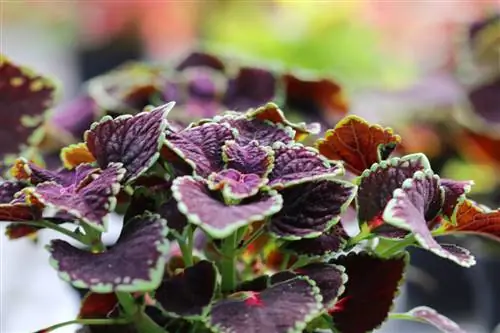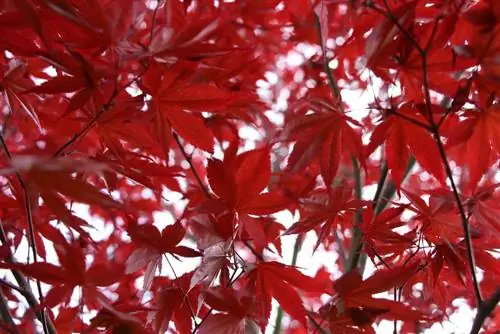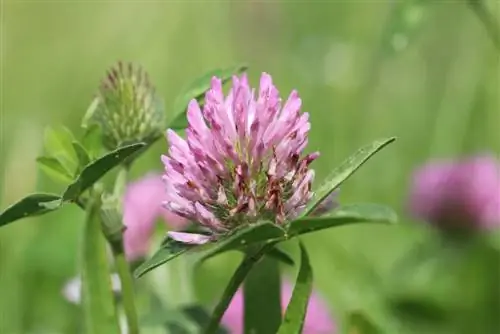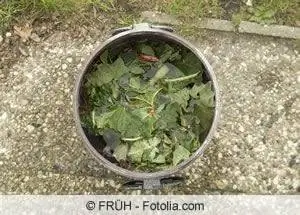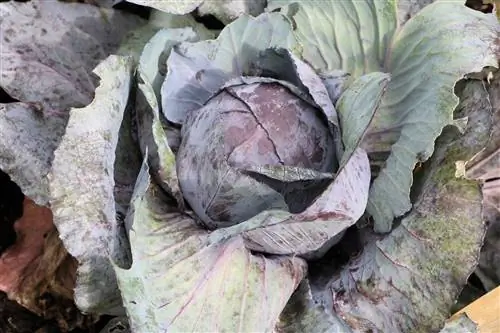- Author admin [email protected].
- Public 2023-12-17 03:39.
- Last modified 2025-01-24 12:45.
The coleus, also known as red nettle, impresses with its monochromatic to variegated leaves. Depending on the variety, they can be marked red, yellow, green, purple or brown.
Profile
- Botanical names: Coleus blumei, Solenostemon scutellarioides, Plectranthus scutellarioides
- Synonyms: Solenostemon scutellarioides, Plectranthus scutellarioides
- Plant family: Mint family (Lamiaceae)
- Growth: upright, bushy
- Growth height: 30 to 60 centimeters
- Growth width: 15 to 40 centimeters
- Leaf: plain to colorful, in a wide variety of colors and patterns
- Leaf shape: ovoid, pointed, sawn
- Flowers: inconspicuous, lip-shaped panicles from June to July
- Use: ornamental leaf plant
Location
Basically, coleus, also known as coleus, tolerates sunny to shady locations. However, if the nettle is (too) dark, the leaves lose their bright color and turn green. Therefore, you should use afor Coleus blumei
- sunny till
- unsunny
Select location. Since the leaves burn easily in strong sunlight at midday, you should shade the red nettle in sunny places.
Temperature
Coleus is extremely sensitive to cold. The lower temperature limit is between 12 and 14 degrees Celsius. If the temperatures fall below this, the colored leaf drops its leaves and dies. The ideal temperature for the nettle is 18 degrees Celsius all year round. That's why it is usually kept as a houseplant. However, the decorative foliage plant can spend the summer outdoors on the balcony or terrace. The outdoor season begins when temperatures remain consistently above plus 15 degrees Celsius and ends when they settle at 15 degrees Celsius.
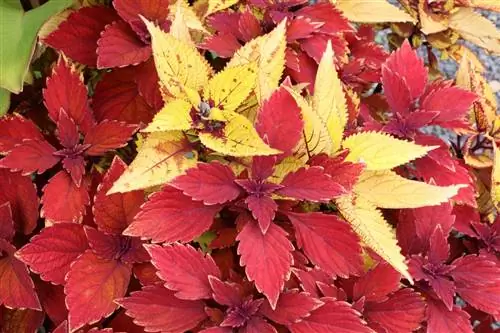
Nevertheless, planting in the garden is possible. Due to its sensitivity to cold, the colorful leaf is only cultivated as an annual when planted out, which also applies to balcony boxes. So that you don't have to do without decorative foliage plants next year, you should propagate the nettle in the summer.
Substrate
For bushy and compact growth, coleus needs a substrate that supplies it well with water and nutrients. Regardless of whether you cultivate the coleus in a pot or planted out, the soil should have the following properties:
- humos
- nutrient-rich
- good water retention
- well drained
- pH value: neutral to slightly acidic
Coleus in a pot
For container/pot culture, you should place the red nettle in a larger planter after purchase so that the colorful leaf can develop well. Repotting is possible all year round. However, it is ideal if you carry out the measure in spring. To ensure that your coleus develops well, follow these steps:
- Choose a planter with drainage holes
- Create a drainage layer made of pottery shards and/or gravel on the ground
- add a layer of substrate (normal compost-based potting soil) on top
- Insert colored leaf
- Setting depth: same as when purchasing
- mix some sand or grit into the substrate before filling it up
- pour well
Coleus in the garden / balcony box
You should plant early coleus in the bed or balcony box in mid-May at the earliest, after the Ice Saints. Since the plants are extremely sensitive to cold, you should consider the temperature in your area.
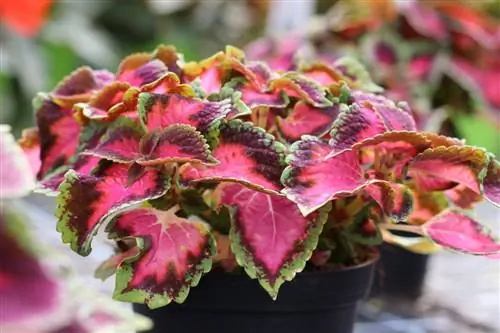
Do the following:
- Dig a planting hole twice the size of the bale
- Planting depth: as when purchasing
- Planting distance: 20 to 30 centimeters (half maximum height)
- Create a drainage layer at the bottom of the planting hole (a few centimeters of sand or grit)
- add a layer of soil over it
- Use coleus
- fill with soil and some compost
- press lightly
- smear well with water
Plant Neighbors
Coleus nettles come into their own as solitary plants as well as in groups. How colorful you make the group of plants depends on your taste. For soloists, it looks nice if you match the color of the planter to the leaves. For example, the following are suitable for combination with other plants:
- Hardworking Lieschen
- Fuchsias
- Begonias
- evergreen grasses, ferns, ivy
Pouring
Coleus blumei needs a lot of water in summer. The red nettle cannot cope with drought. Nevertheless, you shouldn't mean too well, because the foliage plants cannot tolerate waterlogging either. Water your coleus
- regularly and with
- with lime-free water.
You should remove excess water from the saucer after a few minutes. You can also freshen up the leaves in the evening by spraying them with lime-free water.
Note:
If coleus suffers from drought even for a short time, they shed their leaves.
Fertilize
Additional nutrients are welcome for potted plants during the growing season if they have not been recently repotted. A conventional liquid fertilizer for green plants or flowering plants is completely sufficient. Ideally you fertilize from April to August
- one houseplant every two weeks
- Coleus on the balcony weekly
Tip:
If you use a long-term fertilizer in the form of fertilizer sticks, you should only give the colored leaf half the dose.
Plants planted in the garden or balcony box do not need any additional nutrients if you mixed compost or horn shavings into the soil when planting them.
Cutting
You can ensure bushy growth if you trim young coleus from the start. For older plants you should
- Older and bare shoots regularly thin out and
- cut them back more as needed (just above a pair of leaves).
Tip:
By regularly breaking off the shoot tips, you stimulate the colored leaves to grow bushy.
Flowers
Since the leaves are the real star of this nettle, many hobby gardeners avoid the inconspicuous flowers. They are pinched off in the bud stage so that their development does not cost the colored leaf any unnecessary energy, which can have a detrimental effect on the leaf color.
Overwintering & Repotting
If the coleus spends the summer outdoors, they overwinter
- bright
- at a temperature between 15 and 20 degrees Celsius
All-season houseplants can remain in their usual location. All plants need less water in winter.
You should repot young coleus every two months. Adult plants go into a new container as soon as the old pot has rooted.
Propagate
The red nettle can be propagated with cuttings or seeds.
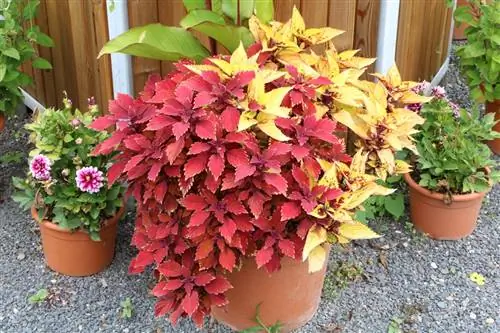
Seeds
Propagate your own coleus with seeds is not recommended. On the one hand, the flower buds must not be pinched off, and on the other hand, the plants must spend the summer outdoors so that fertilization can take place. In addition, it is impossible to calculate what colors the leaves of the new nettles will have. In addition, this type of propagation is a very lengthy process.
Cuttings
Propagation with cuttings is easy. The ideal time is in summer or autumn. When selecting shoots, it is best to follow the following criteria:
- he althy, strong
- without flower bud
- not too fresh, but a little more robust
- at least two pairs of leaves with particularly characteristic coloring / markings
- Length for insertion: about ten centimeters
For rooting, place the top cuttings either in a glass with water or directly in the substrate. The following applies to both methods: If propagation takes place in summer, the young plants can spend the remaining time outdoors. When propagating in the fall, place the plants on a bright windowsill. For them, the outdoor season doesn't start until next year.
Water glass method
- fill a suitable glass with lukewarm water
- remove the lower pair of leaves from the cutting
- Leaves must not come into contact with the water (risk of rot)
- place in a bright place (without direct sun)
- Change water every few days
After one to a maximum of two weeks, the cutting should have formed roots. Once it has reached a length of about five centimeters, you can place it in a pot with standard soil mixed with a little sand.
Method substrate
- Prepare a small pot with uniform or growing soil
- Place the cutting two to three centimeters deep into the moist substrate
- remove the lower pair of leaves if necessary
- place in a bright place without direct sun
- Keep substrate slightly moist
Tip:
You can tell whether the propagation was successful by the fact that the cutting forms new leaves.
Pests & Toxicity
In dry and warm air, spider mite infestations occasionally occur. Identify the typical webs on the coleus, spray the coleus with water and/or cut off severely affected shoots.
Coleus is slightly poisonous and not suitable for consumption. The toxicity for dogs and cats is discussed differently. Red nettle can be fatal for small rodents and pet birds.

